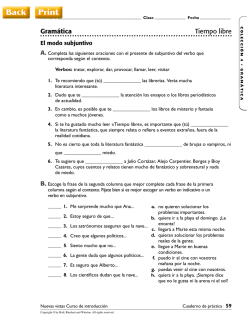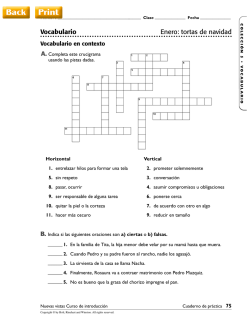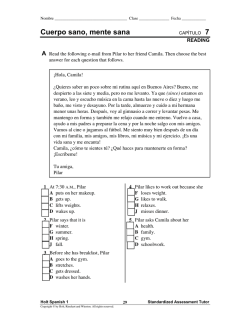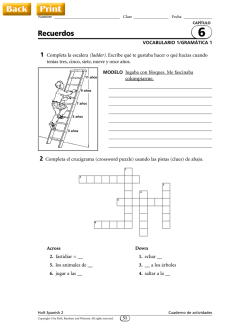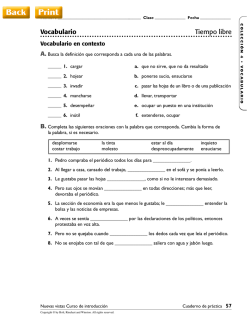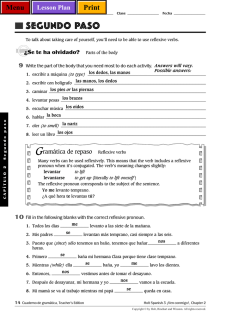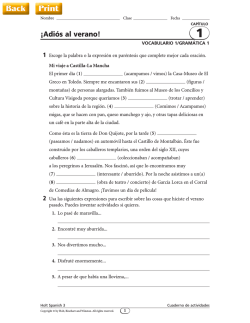
Transparencies
Mapa 5 México Holt Spanish 1 Copyright © by Holt, Rinehart and Winston. All rights reserved. N 12 13 1 3 4 CLAVE DE ESTADOS 2 Teaching Transparencies 3 4 5 6 7 8 9 10 11 12 13 14 NAYARIT COLIMA AGUASCALIENTES GUANAJUATO QUERÉTARO HIDALGO MÉXICO DISTRITO FEDERAL MORELOS PUEBLA TLAXCALA NUEVO LEÓN SAN LUIS POTOSÍ TABASCO 5 6 7 8 9 2 11 10 14 0 0 125 250 Kilómetros 125 250 Millas TEACHING TRANSPARENCY 1 Mapa 5 México ESTADOS UNIDOS DE AMÉ RICA Mexicali Tucson Nogales Baton Rouge Nueva Orleáns Galveston Laredo Nuevo Laredo NA e adr ra M SI al nt de ci Oc A UR IA S LO N McAllen Brownsville Reynosa Monterrey Matamoros 12 Golfo de México TAMAULIPAS Or 13 ZACATECAS Ciudad Victoria Zacatecas 1 3 Tepic San Luis Potosí Aguascalientes Guanajuato Puerto Vallarta Guadalajara VERACRUZ 4 5 Río L e r m a Querétaro Mérida JALISCO 6 Pachuca YUCATÁN Campeche Morelia F 7 México, D.F. Veracruz Colima IC 11 Tlaxcala MICHOACÁN Toluca 8 2 O CAMPECHE QUINTANA Puebla ROO 9 R ío 10 Chetumal a l s Taxco Villahermosa o as 14 GUERRERO U ien N ta ÉA l O C Í 250 Millas Golfo de Tehuantepec a 125 BELICE su int 250 Kilómetros San Cristóbal de Las Casas CHIAPAS ac 0 125 Oaxaca OAXACA m 0 Rí Acapulco Cozumel GUATEMALA HONDURAS TEACHING TRANSPARENCY A B NAYARIT COLIMA AGUASCALIENTES GUANAJUATO QUERÉTARO HIDALGO MÉXICO DISTRITO FEDERAL MORELOS PUEBLA TLAXCALA NUEVO LEÓN SAN LUIS POTOSÍ TABASCO P 14 te RN C 9 10 11 12 13 Houston San Antonio No r FO O Teaching Transparencies 3 4 5 6 7 8 d LI Torreón DURANGO Durango Mazatlán CLAVE DE ESTADOS 2 COAHUILA MÉXICO Puerto Arturo Del Río av Br o e l Sier CA La Paz os e e dr Ma A Culiacán G ra n d IA CHIHUAHUA Chihuahua J ío R RN Hermosillo rra Sie IFO SONORA BA 1 El Paso Ciudad Juárez Rí o CAL Nogales R í o Conch Tijuana BAJA Holt Spanish 1 Copyright © by Holt, Rinehart and Winston. All rights reserved. San Diego Clase Fecha TEACHING TRANSPARENCY MASTER 250 Millas 125 Teaching Transparencies 0 250 Kilómetros 125 0 Nombre Mapa 5 México Holt Spanish 1 Copyright © by Holt, Rinehart and Winston. All rights reserved. N CAPÍTULO 6 ¡A comer! TEACHING TRANSPARENCY Bell Work 6.1 Teacher's Edition: Level 1, p. 196 (1B, p. 40) Match each chore to the place it occurs. _____ 1. Ana corta el césped. _____ 2. Ana hace la cama. _____ 3. Ana cocina el almuerzo. _____ 4. Ana arregla el sofá. Bell Work 6.2 a. la cocina b. el jardín c. la sala d. el cuarto Teacher's Edition: Level 1, p. 200 (1B, p. 46) Put the following conversation in logical order, from a to e. _____ 1. ¿Y para tomar? _____ 2. Quisiera una ensalada. _____ 3. ¿Algo más? _____ 4. ¿Qué desea usted? _____ 5. Para tomar, quiero un vaso de agua. Holt Spanish 1 Copyright © by Holt, Rinehart and Winston. All rights reserved. Teaching Transparencies CAPÍTULO 6 ¡A comer! (Overlay) TEACHING TRANSPARENCY Bell Work 6.1 Teacher's Edition: Level 1, p. 196 (1B, p. 40) Match each chore to the place it occurs. b _____ 1. Ana corta el césped. d _____ 2. Ana hace la cama. a _____ 3. Ana cocina el almuerzo. c _____ 4. Ana arregla el sofá. Bell Work 6.2 a. la cocina b. el jardín c. la sala d. el cuarto Teacher's Edition: Level 1, p. 200 (1B, p. 46) Put the following conversation in logical order, from a to e. c _____ 1. ¿Y para tomar? b _____ 2. Quisiera una ensalada. e _____ 3. ¿Algo más? a _____ 4. ¿Qué desea usted? d _____ 5. Para tomar, quiero un vaso de agua. Holt Spanish 1 Copyright © by Holt, Rinehart and Winston. All rights reserved. Teaching Transparencies CAPÍTULO 6 ¡A comer! TEACHING TRANSPARENCY Bell Work 6.3 Teacher's Edition: Level 1, p. 202 (1B, p. 48) Complete the sentences with the correct form of ser or estar. 1. La sopa ____________ fría. 2. Mi madre y yo ____________ altas. 3. El lápiz ____________ encima del escritorio. 4. Los postres de aquí ____________ ricos. 5. Es muy tarde. ____________ las nueve y media. Bell Work 6.4 Teacher's Edition: Level 1, p. 204 (1B, p. 50) Complete the following sentences with the correct form of pedir or servir. 1. Conchita siempre ____________ agua para tomar en los restaurantes. 2. Esteban y Carlos nunca ____________ salsa. No les gusta comer nada picante. 3. Mi madre ____________ la cena a las ocho todos los días. 4. Javier y yo ____________ un sándwich de jamón al mediodía. 5. Los restaurantes mexicanos ____________ comida riquísima. Holt Spanish 1 Copyright © by Holt, Rinehart and Winston. All rights reserved. Teaching Transparencies CAPÍTULO 6 ¡A comer! (Overlay) TEACHING TRANSPARENCY Bell Work 6.3 Teacher's Edition: Level 1, p. 202 (1B, p. 48) Complete the sentences with the correct form of ser or estar. está 1. La sopa ____________ fría. somos 2. Mi madre y yo ____________ altas. está 3. El lápiz ____________ encima del escritorio. son 4. Los postres de aquí ____________ ricos. Son 5. Es muy tarde. ____________ las nueve y media. Bell Work 6.4 Teacher's Edition: Level 1, p. 204 (1B, p. 50) Complete the following sentences with the correct form of pedir or servir. pide 1. Conchita siempre ____________ agua para tomar en los restaurantes. piden 2. Esteban y Carlos nunca ____________ salsa. No les gusta comer nada picante. sirve 3. Mi madre ____________ la cena a las ocho todos los días. pedimos 4. Javier y yo ____________ un sándwich de jamón al mediodía. sirven 5. Los restaurantes mexicanos ____________ comida riquísima. Holt Spanish 1 Copyright © by Holt, Rinehart and Winston. All rights reserved. Teaching Transparencies CAPÍTULO 6 ¡A comer! TEACHING TRANSPARENCY Bell Work 6.5 Teacher's Edition: Level 1, p. 208 (1B, p. 54) Unscramble the words and conjugate the verbs to write logical sentences. 1. amigo / ensalada / Andrés / mi / preferir / la _______________________________________________________________ 2. nuestra / helado / poder / familia / no / comer _______________________________________________________________ 3. hermano / probar / tu / nuevo / nunca / nada _______________________________________________________________ 4. yo / siempre / los / probar / todos / postres _______________________________________________________________ 5. padre / comida / la / nuestro / preferir / caliente _______________________________________________________________ Bell Work 6.6 Teacher's Edition: Level 1, p. 212 (1B, p. 60) For each list, give the correct category of food or meal. 1. los huevos, el pan tostado, el tocino __________________________________ 2. el sándwich, la sopa, la manzana _____________________________________ 3. la manzana, la naranja, el durazno ___________________________________ 4. el arroz con pollo, las zanahorias _____________________________________ 5. el flan, el helado __________________________________________________ Holt Spanish 1 Copyright © by Holt, Rinehart and Winston. All rights reserved. Teaching Transparencies CAPÍTULO 6 ¡A comer! (Overlay) TEACHING TRANSPARENCY Bell Work 6.5 Teacher's Edition: Level 1, p. 208 (1B, p. 54) Unscramble the words and conjugate the verbs to write logical sentences. 1. amigo / ensalada / Andrés / mi / preferir / la Mi amigo Andrés prefiere la ensalada. _______________________________________________________________ 2. nuestra / helado / poder / familia / no / comer Nuestra familia no puede comer helado. _______________________________________________________________ 3. hermano / probar / tu / nuevo / nunca / nada Tu hermano nunca prueba nada nuevo. _______________________________________________________________ 4. yo / siempre / los / probar / todos / postres Yo siempre pruebo todos los postres. _______________________________________________________________ 5. padre / comida / la / nuestro / preferir / caliente Nuestro padre prefiere la comida caliente. _______________________________________________________________ Bell Work 6.6 Teacher's Edition: Level 1, p. 212 (1B, p. 60) For each list, give the correct category of food or meal. el desayuno 1. los huevos, el pan tostado, el tocino __________________________________ el almuerzo 2. el sándwich, la sopa, la manzana _____________________________________ las frutas 3. la manzana, la naranja, el durazno ___________________________________ la cena 4. el arroz con pollo, las zanahorias _____________________________________ el postre 5. el flan, el helado __________________________________________________ Holt Spanish 1 Copyright © by Holt, Rinehart and Winston. All rights reserved. Teaching Transparencies CAPÍTULO 6 ¡A comer! TEACHING TRANSPARENCY Bell Work 6.7 Teacher's Edition: Level 1, p. 214 (1B, p. 62) Write the answer to each question, using a direct object pronoun. 1. ¿Quién pide el café? Iñaki __________________________________________________________. 2. ¿Quién limpia la casa hoy? Tú ____________________________________________________________. 3. ¿Quién sirve la cena en tu casa? Mis padres _____________________________________________________. 4. ¿Quién prepara los postres? Nosotros _______________________________________________________. 5. ¿Quién va a sacar la basura esta noche? Yo ____________________________________________________________. Bell Work 6.8 Teacher's Edition: Level 1, p. 216 (1B, p. 64) Tell this person how to remedy each problem. 1. Tengo mucha hambre. _____________________________________________ 2. Mis notas son malas. ______________________________________________ 3. Estoy aburrido en casa. ____________________________________________ 4. No me gusta la sopa. ______________________________________________ 5. Tengo sed. ______________________________________________________ Holt Spanish 1 Copyright © by Holt, Rinehart and Winston. All rights reserved. Teaching Transparencies CAPÍTULO 6 ¡A comer! (Overlay) TEACHING TRANSPARENCY Bell Work 6.7 Teacher's Edition: Level 1, p. 214 (1B, p. 62) Write the answer to each question, using a direct object pronoun. 1. ¿Quién pide el café? pide Iñaki lo __________________________________________________________. 2. ¿Quién limpia la casa hoy? limpias Tú la ____________________________________________________________. 3. ¿Quién sirve la cena en tu casa? la sirven Mis padres _____________________________________________________. 4. ¿Quién prepara los postres? preparamos Nosotros los _______________________________________________________. 5. ¿Quién va a sacar la basura esta noche? voy a sacar Yo la ____________________________________________________________. Bell Work 6.8 Teacher's Edition: Level 1, p. 216 (1B, p. 64) Tell this person how to remedy each problem. Answers will vary. Possible answers. 1. Tengo mucha hambre. Come. _____________________________________________ más. 2. Mis notas son malas. Estudia ______________________________________________ Sal de la casa. 3. Estoy aburrido en casa. ____________________________________________ comas la sopa. 4. No me gusta la sopa. No ______________________________________________ algo. 5. Tengo sed. Bebe ______________________________________________________ Holt Spanish 1 Copyright © by Holt, Rinehart and Winston. All rights reserved. Teaching Transparencies CAPÍTULO 6 Vocabulario 6.1 TEACHING TRANSPARENCY ¿Qué vas a pedir? Holt Spanish 1 Copyright © by Holt, Rinehart and Winston. All rights reserved. Teaching Transparencies CAPÍTULO 6 Vocabulario 6.1 (Overlay) TEACHING TRANSPARENCY ¿Qué vas a pedir? ¿Qué prefieres pedir de almuerzo en este restaurante? un sándwich de atún una ensalada la salsa una ensalada de frutas unas papas fritas Holt Spanish 1 Copyright © by Holt, Rinehart and Winston. All rights reserved. un sándwich de jamón con queso Teaching Transparencies Nombre Clase Fecha CAPÍTULO 6 Vocabulario 6.1 TEACHING TRANSPARENCY MASTER ¿Qué vas a pedir? Holt Spanish 1 Copyright © by Holt, Rinehart and Winston. All rights reserved. Teaching Transparencies CAPÍTULO 6 Vocabulario 6.2 TEACHING TRANSPARENCY Para tomar, puedes pedir… En la mesa hay… Holt Spanish 1 Copyright © by Holt, Rinehart and Winston. All rights reserved. Teaching Transparencies CAPÍTULO 6 Vocabulario 6.2 (Overlay) TEACHING TRANSPARENCY Para tomar, puedes pedir… un jugo de naranja el agua un refresco la leche En la mesa hay… un plato hondo un vaso una cuchara una servilleta un plato un tenedor un cuchillo Holt Spanish 1 Copyright © by Holt, Rinehart and Winston. All rights reserved. Teaching Transparencies Nombre Clase Fecha CAPÍTULO 6 Vocabulario 6.2 TEACHING TRANSPARENCY MASTER Para tomar, puedes pedir… En la mesa hay… Holt Spanish 1 Copyright © by Holt, Rinehart and Winston. All rights reserved. Teaching Transparencies CAPÍTULO Vocabulario 6.3 6 TEACHING TRANSPARENCY El desayuno en casa Holt Spanish 1 Copyright © by Holt, Rinehart and Winston. All rights reserved. Teaching Transparencies CAPÍTULO 6 Vocabulario 6.3 (Overlay) TEACHING TRANSPARENCY El desayuno en casa los cereales el durazno la naranja el chocolate la manzana el café con leche el pan tostado el pan dulce el tocino los huevos Holt Spanish 1 Copyright © by Holt, Rinehart and Winston. All rights reserved. Teaching Transparencies Nombre Clase Fecha CAPÍTULO Vocabulario 6.3 6 TEACHING TRANSPARENCY MASTER El desayuno en casa Holt Spanish 1 Copyright © by Holt, Rinehart and Winston. All rights reserved. Teaching Transparencies CAPÍTULO Vocabulario 6.4 6 TEACHING TRANSPARENCY ¿Qué hay de cena? Holt Spanish 1 Copyright © by Holt, Rinehart and Winston. All rights reserved. Teaching Transparencies CAPÍTULO 6 Vocabulario 6.4 (Overlay) TEACHING TRANSPARENCY ¿Qué hay de cena? el bróculi las espinacas el maíz las zanahorias el pollo la carne el pastel Holt Spanish 1 Copyright © by Holt, Rinehart and Winston. All rights reserved. Teaching Transparencies Nombre Clase Fecha CAPÍTULO Vocabulario 6.4 6 TEACHING TRANSPARENCY MASTER ¿Qué hay de cena? Holt Spanish 1 Copyright © by Holt, Rinehart and Winston. All rights reserved. Teaching Transparencies CAPÍTULO Situación ¿Tienes hambre? 6 TEACHING TRANSPARENCY Holt Spanish 1 Copyright © by Holt, Rinehart and Winston. All rights reserved. Teaching Transparencies Nombre Clase Fecha CAPÍTULO Situación ¿Tienes hambre? 6 TEACHING TRANSPARENCY MASTER Holt Spanish 1 Copyright © by Holt, Rinehart and Winston. All rights reserved. Teaching Transparencies CAPÍTULO 6 Picture Sequences TEACHING TRANSPARENCY Comunicación, Level 1, p. 217 (1B, p. 65) b. a. c. Repaso, Level 1, p. 223 (1B, p. 75) a. b. c. d. Holt Spanish 1 Copyright © by Holt, Rinehart and Winston. All rights reserved. Teaching Transparencies Nombre Clase Fecha CAPÍTULO 6 Picture Sequences TEACHING TRANSPARENCY MASTER Comunicación, Level 1, p. 217 (1B, p. 65) —¿Qué hago con la leche? —Ponla en el refrigerador. —¿Y qué hago con la basura? —Sácala. —¿Debo lavar los platos? —Sí, lávalos. —¿Paso la aspiradora en la sala? —Sí, pásala. —¿Tengo que hacer la cama? —Sí, hazla. —¿Y también debo organizar el cuarto? —Sí, organízalo. Repaso, Level 1, p. 223 (1B, p. 75) Al señor Gonzaga le gusta el pescado y lo prepara con frecuencia. A su hija Josefina no le gusta mucho y prefiere no comerlo. En el comedor los dos empiezan a comer y Josefina prueba el pescado. Para ella, está muy picante y no sabe qué hacer. Su padre dice que la leche es muy buena y la sirve en un vaso para Josefina. Josefina la toma y puede terminar su cena. Holt Spanish 1 Copyright © by Holt, Rinehart and Winston. All rights reserved. Teaching Transparencies Fine Art CAPÍTULO 6 TEACHING TRANSPARENCY Teaching Transparencies painting ©2004 Banco de México Diego Rivera & Frida Kahlo Museums Trust, Av. Cinco de Mayo No. 2, Col. Centro, Del. Cuauhtémoc 06059, México, D. F.; photo © Archivo Iconografico, S.A./CORBIS; Reproduction Authorized by the National Institute of Fine Arts and Literature, Mexico City. Holt Spanish 1 Copyright © by Holt, Rinehart and Winston. All rights reserved. The Market of Cuernavaca in the Age of the Spanish Conquest, de Diego Rivera (1886–1957) Nombre Fine Art Clase Fecha CAPÍTULO 6 TEACHING TRANSPARENCY MASTER Teaching Transparencies painting ©2004 Banco de México Diego Rivera & Frida Kahlo Museums Trust, Av. Cinco de Mayo No. 2, Col. Centro, Del. Cuauhtémoc 06059, México, D. F.; photo © Archivo Iconografico, S.A./CORBIS; Reproduction Authorized by the National Institute of Fine Arts and Literature, Mexico City. Holt Spanish 1 Copyright © by Holt, Rinehart and Winston. All rights reserved. The Market of Cuernavaca in the Age of the Spanish Conquest, de Diego Rivera (1886–1957) Nombre Clase Fecha CAPÍTULO 6 ¡A comer! VOCABULARIO 1 1 2 El almuerzo de Eugenia está muy rico. Say whether each of the following statements about Eugenia’s lunch is lógico or ilógico. ilógico 1. El sándwich de queso es de atún. lógico 2. El jugo de naranja no tiene salsa picante. ilógico 3. La leche está salada. lógico 4. El helado está frío. ilógico 5. La ensalada de frutas está caliente. ilógico 6. Las servilletas están riquísimas. lógico 7. El vaso no tiene sopa. The following items are either foods or place settings. Write each one under the correct category. el queso el vaso las papas 3 la servilleta el refresco el plato el jamón la ensalada el atún el tenedor el plato hondo la cuchara el jugo el cuchillo Food Place settings el queso la ensalada el jugo el refresco el jamón las papas el atún el plato hondo la servilleta el cuchillo el tenedor el vaso el plato la cuchara Es la hora del almuerzo. Match each description on the left with the name of a food on the right. b 1. Es rojo y muy rico para tomar. e 2. Me gusta comer esto (this) de frutas o de verduras. c 3. Es un postre delicioso. d 4. Son saladas, calientes y muy buenas con las hamburguesas. a 5. Es bueno comer esto con la comida mexicana. Holt Spanish 1 Copyright © by Holt, Rinehart and Winston. All rights reserved. a. la salsa picante b. el jugo de tomate c. el flan d. las papas fritas e. la ensalada Cuaderno de vocabulario y gramática 61 Nombre Clase Fecha CAPÍTULO 6 VOCABULARIO 1 4 5 Number the sentences in order to make a logical conversation between Diana and her waiter. The first one has been done for you. 3 ¿Y para tomar? 5 ¿Desea algo de postre? 4 Para tomar, quiero un vaso de agua. 1 ¿Qué desea usted? 7 ¿Algo más? 2 Quisiera un sándwich de jamón. 6 Sí, ¿me trae un helado, por favor? 8 ¿Me trae la cuenta, por favor? Alfredo’s waiter has brought his lunch but forgot to bring place settings. Tell what Alfredo needs in order to eat the following foods. Answers may vary. Possible answers: MODELO el agua un vaso 1. el sándwich de atún un plato 2. el jugo de naranja un vaso 3. la sopa de verduras una cuchara, un plato hondo 4. la ensalada un plato, un tenedor, un cuchillo 5. las papas fritas un plato, un tenedor 6 Lourdes is training to be a waitress in her family’s café. Write the question that she would ask for each of the given answers. 1. —¿Qué desea usted? —Quisiera un sándwich de atún. 2. —¿Y para tomar? —Para tomar quiero jugo de naranja. 3. —¿Qué tal está la sopa? —¡La sopa está riquísima, gracias! 4. —¿Desea algo de postre? —Sí, quiero un flan. 5. —¿Algo más? —¿Nos trae la cuenta, por favor? Holt Spanish 1 Copyright © by Holt, Rinehart and Winston. All rights reserved. Cuaderno de vocabulario y gramática 62 Nombre Clase Fecha CAPÍTULO 6 VOCABULARIO 1 7 Marú siempre come en la cafetería. Con base en (based on) el menú, contesta cierto o falso para cada oración (sentence). Cafetería del Colegio Buendía Menú de la semana 8 lunes hamburguesa con tomate, papas fritas martes sándwich de atún, flan, leche miércoles sopa de verduras, ensalada de papas jueves sándwich de jamón con tomate y queso, fruta viernes pizza de queso, jugos cierto 1. El lunes Marú come hamburguesa con papas fritas. falso 2. La cafetería sirve (serves) refrescos. falso 3. El viernes la cafetería tiene pizza de jamón. cierto 4. El martes Marú come sándwich y postre. cierto 5. Los estudiantes del Colegio Buendía comen papas. Fernanda is ordering in a restaurant, but she only likes fruit salad. Write her response to each suggestion her friends make. Use each expression from the box in your answers. Answers may vary. Possible answers: salada de acuerdo encanta nunca ¡Ay no! 1. —¿Qué tal si pruebas un sándwich de queso? —¡Ay no! No me gusta. 2. —Aquí preparan muy bien la salsa picante. —No estoy de acuerdo. Es muy picante. 3. —¿Qué tal está la ensalada de verduras? —Está un poco salada. 4. —¿Qué tal si pides una sopa de tomate? —Nunca pido sopa de tomate. No me gusta. 5. —¡Qué rica está la ensalada de frutas! —Sí, me encanta. Holt Spanish 1 Copyright © by Holt, Rinehart and Winston. All rights reserved. Cuaderno de vocabulario y gramática 63 Nombre Clase Fecha CAPÍTULO 6 ¡A comer! GRAMÁTICA 1 Ser and estar • Both ser and estar are used for the verb to be in English. • Use the verb estar: 1) to say where someone or something is located. La leche está en la mesa. 2) to ask and say how someone is doing. El hombre está bien. 3) to say how something tastes, looks, or feels at a certain time. El flan está rico. • Use the verb ser: 1) to tell the time, the day, or the date. Es la una. Hoy es lunes. 2) to identify someone. Ésta es la profesora. 3) to say where someone is from. Ella es de Perú. 4) to describe what someone or something is normally like. La leche es rica. 9 Señora Vidales left the following instructions for the babysitter. Complete them using the correct forms of ser and estar. Hola, ¿cómo (1) (2) estás están ? Los sándwiches para el almuerzo Están en la cocina. (3) La sopa de Susanita (4) es de verduras. La señora Vásquez es va a venir a las 3:00 para limpiar la casa. Ella (5) con el pelo castaño y (6) es viernes. Los números están de teléfono de emergencia (8) delgada de Venezuela. Hoy yo regreso es del trabajo a las 4:30 porque (7) 10 fríos. al lado del teléfono. The following sentences are generalizations about types of food. Rewrite them to talk about what Jimena and Rodrigo are eating for lunch today. MODELO El flan es dulce (sweet). El flan está dulce. 1. El queso es horrible. El queso está horrible. 2. La sopa es caliente. La sopa está caliente. 3. Las papas fritas son buenas. Las papas fritas están buenas. 4. La salsa de tomate es picante. La salsa de tomate está picante. 5. La ensalada de frutas es rica. La ensalada de frutas está rica. 6. El jamón es salado. El jamón está salado. Holt Spanish 1 Copyright © by Holt, Rinehart and Winston. All rights reserved. Cuaderno de vocabulario y gramática 64 Nombre Clase Fecha CAPÍTULO 6 GRAMÁTICA 1 Pedir and servir The e changes to i in all the present tense forms of pedir (to ask for, to order) and servir (to serve), except the nosotros and vosotros forms. yo pido, sirvo nosotros(as) pedimos, servimos tú pides, sirves vosotros(as) pedís, servís usted/él/ella pide, sirve ustedes/ellos/ellas piden, sirven Yo pido ensalada para el almuerzo. ¿Qué sirven en este restaurante? I order salad for lunch. What do they serve in this restaurant? 11 Escoge la forma correcta del verbo servir para decir qué sirve cada persona. b 12 1. ¿Qué comida _____ ustedes? a. sirvo b. sirven b 2. Yo _____ comida mexicana en mi casa. a. servir b. sirvo a 3. Amalia _____ refrescos y papas fritas en su fiesta. a. sirve b. sirven b 4. Nosotros _____ jugo y agua para el almuerzo. a. servís b. servimos a 5. Tú _____ postre después de la comida. a. sirves b. sirven Escribe quién pide estas comidas en el restaurante. Sigue el modelo. MODELO Leslie / papas Leslie pide las papas. 1. tú y yo / sándwiches de queso y tomate Tú y yo pedimos los sándwiches de queso y tomate. 2. Elsa y Ben / sopa Elsa y Ben piden la sopa. 3. usted / ensalada de verduras Usted pide la ensalada de verduras. 4. tú / jugo de naranja Tú pides el jugo de naranja. 5. Papá / salsa picante Papá pide la salsa picante. 6. mi amiga / atún Mi amiga pide el atún. Holt Spanish 1 Copyright © by Holt, Rinehart and Winston. All rights reserved. Cuaderno de vocabulario y gramática 65 Nombre Clase Fecha CAPÍTULO 6 GRAMÁTICA 1 Preferir, poder, and probar • The e in the stem of preferir changes to ie, except in the nosotros and vosotros forms. Use preferir with a noun to say what one prefers; use preferir with a verb to say what one prefers to do. yo prefiero nosotros(as) preferimos tú prefieres vosotros(as) preferís usted/él/ella prefiere ustedes/ellos/ellas prefieren • The o in poder and probar changes to ue, except in the nosotros and vosotros forms. Use poder + an infinitive to ask a favor or to say what someone can, may, or is able to do. Probar means to taste or to try something. yo puedo, pruebo nosotros(as) podemos, probamos tú puedes, pruebas vosotros(as) podéis, probáis usted/él/ella puede, prueba ustedes/ellos/ellas pueden, prueban ¿Puedes traer el queso, por favor? ¿Por qué no pruebas la sopa? Can you please bring the cheese? Why don’t you try the soup? 13 Everyone in Elena’s family wants to eat different things. Choose the correct form of preferir to say what each one prefers. MODELO La hermana (prefiero / prefiere) sopa de verduras. prefiere prefiero 1. Yo (preferimos / prefiero) el queso. 2. Julio y tú (prefieren / prefieres) la sopa. prefieren 3. Elena y yo (preferimos / prefiere) un sándwich. preferimos 4. Usted (prefieren / prefiere) tomar jugo. prefiere 5. Los padres (preferís / prefieren) comer una ensalada. 14 prefieren Use the correct forms of the verbs preferir, poder, probar, and pedir to complete Josefina’s description of a typical evening at a restaurant with her little sister. prefiero Yo (1) puede hermanita. Ella (2) (3) no salir a los restaurantes con mi pedimos ser terrible. Cuando nosotros la comida, mi hermana (4) pide jugo y refrescos pero no (5) prueba la sopa. Tampoco prueba la comida y nosotros no (6) podemos comer en paz (in peace). pueden Los camareros (waiters) no (7) nada. ¡Ellos (8) prefieren no servir nuestra mesa! Holt Spanish 1 Copyright © by Holt, Rinehart and Winston. All rights reserved. traerle (bring her) Cuaderno de vocabulario y gramática 66 Nombre Clase Fecha CAPÍTULO 6 ¡A comer! VOCABULARIO 2 15 16 17 Match each food with its correct description. a 1. Es una fruta. e 2. Es un desayuno. d 3. Es una cena. f 4. Es para tomar. c 5. Es una verdura. b 6. Es un postre. a. la manzana b. el flan c. la zanahoria d. arroz con pollo e. chocolate y pan tostado f. agua Humberto prepara la comida para su familia esta semana. Escribe lógico o ilógico para cada oración (sentence). lógico 1. Humberto sirve carne con arroz y verduras para la cena. ilógico 2. Humberto prepara sándwiches de leche con bróculi. ilógico 3. Humberto necesita verduras para la ensalada de frutas. ilógico 4. Humberto saca el agua del horno. lógico 5. Humberto pone el pollo en el microondas. ilógico 6. Humberto siempre prepara pescado para el desayuno. ilógico 7. Humberto prepara café con leche para dormir. lógico 8. Humberto prepara jugo con unas naranjas. Escribe si las personas comen el desayuno o la cena. Sigue el modelo. MODELO Eduardo come pescado con espinacas. Eduardo come la cena. 1. Miguel come bróculi, arroz y carne. Miguel come la cena. 2. Angélica y Celia beben café con leche y comen pan tostado. Angélica y Celia comen el desayuno. 3. Tomás come dos huevos y tocino, y bebe jugo de naranja. Tomás come el desayuno. 4. Alberto come maíz y pastel. Alberto come la cena. 5. Isabel come cereales y pan dulce. Isabel come el desayuno. 6. Joaquín y Sarita comen zanahorias y pollo. Joaquín y Sarita comen la cena. Holt Spanish 1 Copyright © by Holt, Rinehart and Winston. All rights reserved. Cuaderno de vocabulario y gramática 67 Nombre Clase Fecha CAPÍTULO 6 VOCABULARIO 2 18 Irina likes healthful food, but Gloria doesn’t. Answer the following questions about their likes and dislikes. Answers will vary. Possible answers: MODELO ¿A Irina le gusta más el café o el jugo de naranja? Le gusta más el jugo de naranja. 1. ¿Qué desayuna Gloria, pan dulce o cereales con leche? Gloria desayuna pan dulce. 2. ¿Gloria prefiere merendar refrescos y chocolates o una naranja? Gloria prefiere merendar refrescos y chocolates. 3. ¿Cuál es el almuerzo de Irina, una ensalada de verduras o una pizza? El almuerzo de Irina es una ensalada de verduras. 4. Después del colegio, ¿come Gloria papas fritas o jugo de naranja? Gloria come papas fritas. 5. ¿A Irina le gusta más el helado o las frutas? Le gustan más las frutas. 19 Arnie’s always asking his mother ¿Necesitas ayuda? Write the letter of the picture that illustrates each of his mother’s requests below. a. b. c. c 1. Pon el pastel en el horno. d 2. ¿Por qué no preparas los sándwiches? b 3. Saca el flan del refrigerador, cariño. a 4. Pon la mesa, por favor. Holt Spanish 1 Copyright © by Holt, Rinehart and Winston. All rights reserved. d. Cuaderno de vocabulario y gramática 68 Nombre Clase Fecha CAPÍTULO 6 VOCABULARIO 2 20 Enrique llega a casa con mucha hambre. Completa su conversación con su padre con las palabras del cuadro (box). puedo ayudar saca tengo mucha hambre vamos a cenar microondas por qué no ponlo Enrique ¡Hola, Papá! ¿Qué hay de cena? (1) Tengo mucha hambre . El padre (2) Vamos a cenar carne, papas y espinacas. Puedo ayudar Enrique Mmm, muy bueno. ¿(3) saca El padre Sí, (4) ? el pollo del refrigerador. Enrique Claro. ¿Dónde lo pongo? Ponlo El padre (5) en el (6) microondas . Enrique ¿Algo más? El padre ¿(7) Por qué no preparas las papas? Enrique ¡Claro que sí! 21 Maribel quiere ayudar a preparar la cena. Escribe una respuesta para cada pregunta de Maribel. Answers will vary. Possible answers: MODELO —¿Qué hay de cena? —Vamos a cenar pollo y maíz. 1. —¿Puedo ayudar? —Sí, saca el pollo del horno. 2. —¿Puedo ayudar más? —¿Por qué no preparas el maíz? 3. —¿Pongo la mesa? —Sí, ponla, por favor. 4. —¿Algo más? —Necesitamos vasos, por favor. 5. —¿Qué vamos a tomar? —Vamos a tomar agua o leche. 22 Marcos is a very big eater. What answer might he give to each of the following questions? Answers will vary. Possible answers: 1. ¿Qué desayunas? Siempre desayuno cereales con leche, café, pan dulce, huevos, tocino y fruta. 2. ¿Qué quieres hoy de almuerzo? ¿Qué tal si almorzamos arroz con pollo, pasta, espinacas, pan, jugo y duraznos? 3. ¿Qué hay de cena? Hoy vamos a cenar pescado, bróculi, zanahorias, arroz, leche y postre. Holt Spanish 1 Copyright © by Holt, Rinehart and Winston. All rights reserved. Cuaderno de vocabulario y gramática 69 Nombre Clase Fecha CAPÍTULO 6 ¡A comer! GRAMÁTICA 2 Direct objects and direct object pronouns • A direct object is the person or thing that receives the action of the verb. Guillermo toma jugo. Guillermo drinks juice. • A noun can often be replaced by a pronoun. These are some direct object pronouns in Spanish that can replace a noun. Masculine Feminine lo him, it la her, it los them las them Guillermo lo toma. Guillermo drinks it. • Direct object pronouns are placed before a conjugated verb, or they may be attached to the end of an infinitive. ¿Comes el desayuno? ¿Vas a comer el desayuno? Sí, lo como. Sí lo voy a comer. / Sí, voy a comerlo. 23 Write the direct object after each sentence. Then rewrite the sentence, replacing the direct object with the correct pronoun. MODELO Elisa toma jugo de naranja con la cena. el jugo de naranja: Elisa lo toma con la cena. 1. Emilio siempre come el desayuno. el desayuno: Emilio siempre lo come. 2. Ana y Antonio preparan hamburguesas. hamburguesas: Ana y Antonio las preparan. 3. Yo pongo leche en los cereales. leche: Yo la pongo en los cereales. 4. Yo sirvo refrescos en la fiesta. refrescos: Yo los sirvo en la fiesta. 24 Use the direct object pronoun to say in two different ways who is going to make each item for tonight’s dinner. MODELO Mamá: las papas Mamá va a prepararlas. Mamá las va a preparar. 1. Mariela: la carne Mariela va a prepararla. Mariela la va a preparar. 2. Simón: las verduras Simón va a prepararlas. Simón las va a preparar. 3. Paquita y Danny: el arroz Paquita y Danny van a prepararlo. Paquita y Danny lo van a preparar. Holt Spanish 1 Copyright © by Holt, Rinehart and Winston. All rights reserved. Cuaderno de vocabulario y gramática 70 Nombre Clase Fecha CAPÍTULO 6 GRAMÁTICA 2 Affirmative informal commands • Use affirmative informal commands when you want to give instructions to someone that you would address with the tú form. • To form this type of command, drop the final s from the present-tense tú form. Present-tense tú form Affirmative informal command tú hablas you speak habla speak tú escribes you write escribe write tú pides you ask for pide ask for Pide un huevo para el desayuno. Ask for an egg for breakfast. • The affirmative informal command is irregular in certain verbs: tú tienes (ten), tú vienes (ven), tú pones (pon), tú vas (ve), tú eres (sé), tú haces (haz), and tú sales (sal). • Below are some verbs you might use in the kitchen. tú calientas you heat calienta heat tú sacas you take out saca take out tú cortas you cut corta cut tú abres you open abre open tú mezclas you mix mezcla mix 25 Lola wants to throw a party, but she needs help. Tell her friends what to do by answering their questions with informal commands. Answers will vary. MODELO ¿Escribo invitaciones para mis amigos? Possible answers: Sí, escribe invitaciones para tus amigos. 1. ¿Pongo las sillas en el comedor? Sí, pon las sillas en el comedor. 2. ¿Voy al mercado (market) hoy? Sí, ve al mercado hoy. 3. ¿Vengo temprano para ayudar? Sí, ven temprano. 4. ¿Qué postre hago? Haz el flan. 5. ¿Pido ayuda para organizar la fiesta? Sí, pide ayuda para organizar la fiesta. 26 Raúl is about to start preparing dinner. Tell him four things he should do using affirmative informal commands. Answers will vary. Possible answers: MODELO mezclar Mezcla el jugo. 1. calentar Calienta el horno. 2. sacar Saca los refrescos del refrigerador. 3. cortar Corta el pan. 4. abrir Abre el refrigerador. Holt Spanish 1 Copyright © by Holt, Rinehart and Winston. All rights reserved. Cuaderno de vocabulario y gramática 71 Nombre Clase Fecha CAPÍTULO 6 GRAMÁTICA 2 Affirmative informal commands with pronouns • In a statement, remember to use the direct object pronouns either before the conjugated verb or attached to the end of the infinitive. Lo hago por la tarde. Lo voy a hacer por la tarde. Voy a hacerlo por la tarde. • In an affirmative informal command, always attach the direct object pronoun to the end of the verb. Hazlo esta tarde. Do it this afternoon. • Unless the command is one syllable, you must add a written accent on the stressed vowel. Hazlo. (no accent) Cómela. (accent added) Do it. Eat it. 27 Roberta is in charge of dinner tonight. Write her affirmative informal commands with the appropriate direct object pronoun attached. Don’t forget to add an accent mark if needed. MODELO calentar los pasteles Caliéntalos. Mézclalas. 1. mezclar las ensaladas 2. sacar el pollo del horno 3. poner los platos 4. abrir las ventanas 5. probar el arroz 28 Sácalo del horno. Ponlos. Ábrelas. Pruébalo. Help your friend live a healthier life by answering her questions. Use affirmative informal commands. Whenever possible, use direct object pronouns also. 1. ¿Debo ir a la cama temprano? Sí, ve a la cama muy temprano. Answers may vary. Possible answers: 2. ¿Necesito comer frutas y verduras? Sí, cómelas. 3. ¿Hago la tarea por la tarde o por la noche? Hazla por la tarde. 4. ¿Salgo a pasear en el sol a veces? Sí, sal a pasear en el sol a veces. 5. ¿Debo ser disciplinada (disciplined)? Sí, sé disciplinada. Holt Spanish 1 Copyright © by Holt, Rinehart and Winston. All rights reserved. Cuaderno de vocabulario y gramática 72
© Copyright 2026
